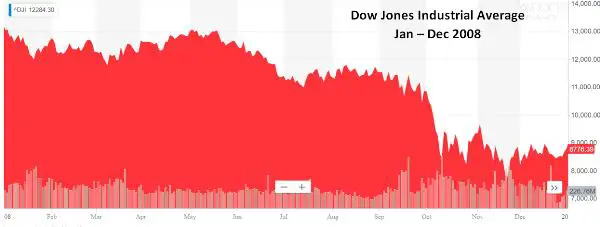-- Published: Tuesday, 4 December 2018 | Print | Disqus
A quick recap of the past couple of months:
Stocks plunge.
The politicians, bureaucrats and bankers who depend on artificially-elevated financial asset prices start to panic.
The Fed announces that maybe it won’t have to raise interest rates any more, and the president announces a truce in the trade war with China.
The markets bounce, leading some to conclude that the worst is over and it’s time to go back to buying the dip.
A larger number of people conclude that the changes in policy were actually just empty words. No actual actions had taken place.
Stocks start falling again. You are here — as this is written on Tuesday Dec 4, the Dow is down about 300 points.
What happens next?
Think of the past few months as the first act in a play that is performed in virtually every business cycle, with later acts following a predictable script. Here’s how it’s likely to go this time:
Words give way to modest action (early 2019). When the markets figure out that empty promises don’t change the underlying reality of slowing growth, falling corporate profits and rising loan defaults, they return to panic mode. Governments are then forced to actually do things to try to stop the bleeding. In the current US case, that means the Fed will announce that it’s done raising rates and will soon start cutting. Trump, meanwhile, will cut a trade deal with China that accomplishes little but removes the future uncertainty.
This will be greeted with another few days of market euphoria, followed by the realization that, again, nothing substantive has changed. Stocks will resume their decline. Let’s call this “2008 revisited.”

The action turns serious (mid-2019). Now Wall Street, Silicon Valley and Washington (i.e., the 1%) are in full-on panic mode, and ready to take radical steps to save themselves. The Fed, which just a few months ago had proclaimed rates to be “neutral,” which is to say just right, starts cutting in earnest. ZIRP is now on the horizon, with NIRP promised in a “whatever it takes” speech by the Fed chair.
The Fed also re-introduces QE, with some twists. Either it’s bigger, or more widespread to include equities and real estate in addition to bonds, or both.
The government starts forgiving student loans and possibly auto mortgages. Tax cuts move through Congress, along with infrastructure spending that dwarfs any previous roads/bridges program.
Federal deficits exceed $2 trillion and will – Washington assures its citizens – stay that high for as long as it takes to restore “normal markets.”
Then things get really interesting (2020 and beyond). At this point in the usual script things start to stabilize. The torrent of public money flowing into financial assets more-or-less offsets the private money that’s fleeing, and prices stop falling. Loans at essentially zero cost start to entice businesses and individuals back into the economy, and private sector debt stops falling and starts rising. “Normality” returns.
The question this time around is whether there’s a limit to aggressive monetary ease. Last time it took tens of trillions of dollars to stabilize a flat-lining economy. In the intervening decade global debt has risen dramatically, which implies that the next bail-out will have to be even bigger. Will it work, or will the markets recoil from the spectacle of electronic printing presses running flat-out forever? Will capital flow away from financial assets and into real things that governments can’t create with a mouse click? And will this stampede out of the currency destabilize the system? Here’s how Austrian School economist Ludwig von Mises described the process:
But then finally the masses wake up. They become suddenly aware of the fact that inflation is a deliberate policy and will go on endlessly. A breakdown occurs. The crack-up boom appears. Everybody is anxious to swap his money against “real” goods, no matter whether he needs them or not, no matter how much money he has to pay for them. Within a very short time, within a few weeks or even days, the things which were used as money are no longer used as media of exchange. They become scrap paper. Nobody wants to give away anything against them.
So which is coming, the standard third act a crack-up boom? That, alas, won’t be clear until after the fact. If the last round of ZIRP, NIRP and QE didn’t create a crack-up boom, it’s possible that the next, even more extreme iterations of these policies will “work” just as well as the originals. It’s also possible that they won’t.
Either way, gold and silver should do just fine.
| Digg This Article
-- Published: Tuesday, 4 December 2018 | E-Mail | Print | Source: GoldSeek.com

